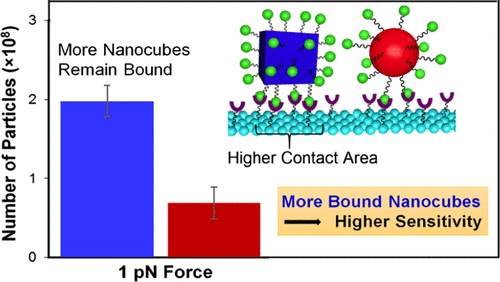Our official English website, www.x-mol.net, welcomes your feedback! (Note: you will need to create a separate account there.)
Magnetic Sensing Potential of Fe3O4 Nanocubes Exceeds That of Fe3O4 Nanospheres.
ACS Omega ( IF 4.1 ) Pub Date : 2017-11-16 , DOI: 10.1021/acsomega.7b01312 Arati G Kolhatkar 1 , Yi-Ting Chen 1 , Pawilai Chinwangso 1, 1 , Ivan Nekrashevich 1 , Gamage C Dannangoda 2 , Ankit Singh 1 , Andrew C Jamison 1 , Oussama Zenasni 1 , Irene A Rusakova 1 , Karen S Martirosyan 2 , Dmitri Litvinov 1, 1, 1 , Shoujun Xu 1 , Richard C Willson 1 , T Randall Lee 1
ACS Omega ( IF 4.1 ) Pub Date : 2017-11-16 , DOI: 10.1021/acsomega.7b01312 Arati G Kolhatkar 1 , Yi-Ting Chen 1 , Pawilai Chinwangso 1, 1 , Ivan Nekrashevich 1 , Gamage C Dannangoda 2 , Ankit Singh 1 , Andrew C Jamison 1 , Oussama Zenasni 1 , Irene A Rusakova 1 , Karen S Martirosyan 2 , Dmitri Litvinov 1, 1, 1 , Shoujun Xu 1 , Richard C Willson 1 , T Randall Lee 1
Affiliation

|
This paper highlights the relation between the shape of iron oxide (Fe3O4) particles and their magnetic sensing ability. We synthesized Fe3O4 nanocubes and nanospheres having tunable sizes via solvothermal and thermal decomposition synthesis reactions, respectively, to obtain samples in which the volumes and body diagonals/diameters were equivalent. Vibrating sample magnetometry (VSM) data showed that the saturation magnetization (Ms) and coercivity of 100-225 nm cubic magnetic nanoparticles (MNPs) were, respectively, 1.4-3.0 and 1.1-8.4 times those of spherical MNPs on a same-volume and same-body diagonal/diameter basis. The Curie temperature for the cubic Fe3O4 MNPs for each size was also higher than that of the corresponding spherical MNPs; furthermore, the cubic Fe3O4 MNPs were more crystalline than the corresponding spherical MNPs. For applications relying on both higher contact area and enhanced magnetic properties, higher-Ms Fe3O4 nanocubes offer distinct advantages over Fe3O4 nanospheres of the same-volume or same-body diagonal/diameter. We evaluated the sensing potential of our synthesized MNPs using giant magnetoresistive (GMR) sensing and force-induced remnant magnetization spectroscopy (FIRMS). Preliminary data obtained by GMR sensing confirmed that the nanocubes exhibited a distinct sensitivity advantage over the nanospheres. Similarly, FIRMS data showed that when subjected to the same force at the same initial concentration, a greater number of nanocubes remained bound to the sensor surface because of higher surface contact area. Because greater binding and higher Ms translate to stronger signal and better analytical sensitivity, nanocubes are an attractive alternative to nanospheres in sensing applications.
中文翻译:

Fe3O4纳米立方体的磁感应势超过Fe3O4纳米球的磁感应势。
本文重点介绍了氧化铁(Fe3O4)颗粒的形状与其磁感应能力之间的关系。我们分别通过溶剂热分解和热分解合成反应合成了尺寸可调的Fe3O4纳米立方体和纳米球,以获得体积和体对角线/直径相等的样品。振动样品磁力分析(VSM)数据显示,相同体积和体积的100-225 nm立方磁性纳米颗粒(MNP)的饱和磁化强度(Ms)和矫顽力分别是球形MNP的1.4-3.0和1.1-8.4倍。等身对角线/直径基准。每种尺寸的立方Fe3O4 MNPs的居里温度也高于相应的球形MNPs的居里温度。此外,立方Fe3O4 MNP比相应的球形MNP更结晶。对于同时依赖于更高接触面积和增强磁性能的应用而言,高等质量的Fe3O4纳米立方体比相同体积或相同物体对角线/直径的Fe3O4纳米球具有明显的优势。我们使用巨磁阻(GMR)感应和力感应残余磁化光谱(FIRMS)评估了合成MNP的感应潜力。通过GMR传感获得的初步数据证实,纳米立方体相对于纳米球具有明显的灵敏度优势。类似地,FIRMS数据显示,当以相同的初始浓度承受相同的力时,由于较高的表面接触面积,因此有更多的纳米立方体保留与传感器表面结合。由于更高的结合力和更高的Ms可以转化为更强的信号和更高的分析灵敏度,
更新日期:2017-11-16
中文翻译:

Fe3O4纳米立方体的磁感应势超过Fe3O4纳米球的磁感应势。
本文重点介绍了氧化铁(Fe3O4)颗粒的形状与其磁感应能力之间的关系。我们分别通过溶剂热分解和热分解合成反应合成了尺寸可调的Fe3O4纳米立方体和纳米球,以获得体积和体对角线/直径相等的样品。振动样品磁力分析(VSM)数据显示,相同体积和体积的100-225 nm立方磁性纳米颗粒(MNP)的饱和磁化强度(Ms)和矫顽力分别是球形MNP的1.4-3.0和1.1-8.4倍。等身对角线/直径基准。每种尺寸的立方Fe3O4 MNPs的居里温度也高于相应的球形MNPs的居里温度。此外,立方Fe3O4 MNP比相应的球形MNP更结晶。对于同时依赖于更高接触面积和增强磁性能的应用而言,高等质量的Fe3O4纳米立方体比相同体积或相同物体对角线/直径的Fe3O4纳米球具有明显的优势。我们使用巨磁阻(GMR)感应和力感应残余磁化光谱(FIRMS)评估了合成MNP的感应潜力。通过GMR传感获得的初步数据证实,纳米立方体相对于纳米球具有明显的灵敏度优势。类似地,FIRMS数据显示,当以相同的初始浓度承受相同的力时,由于较高的表面接触面积,因此有更多的纳米立方体保留与传感器表面结合。由于更高的结合力和更高的Ms可以转化为更强的信号和更高的分析灵敏度,

























 京公网安备 11010802027423号
京公网安备 11010802027423号